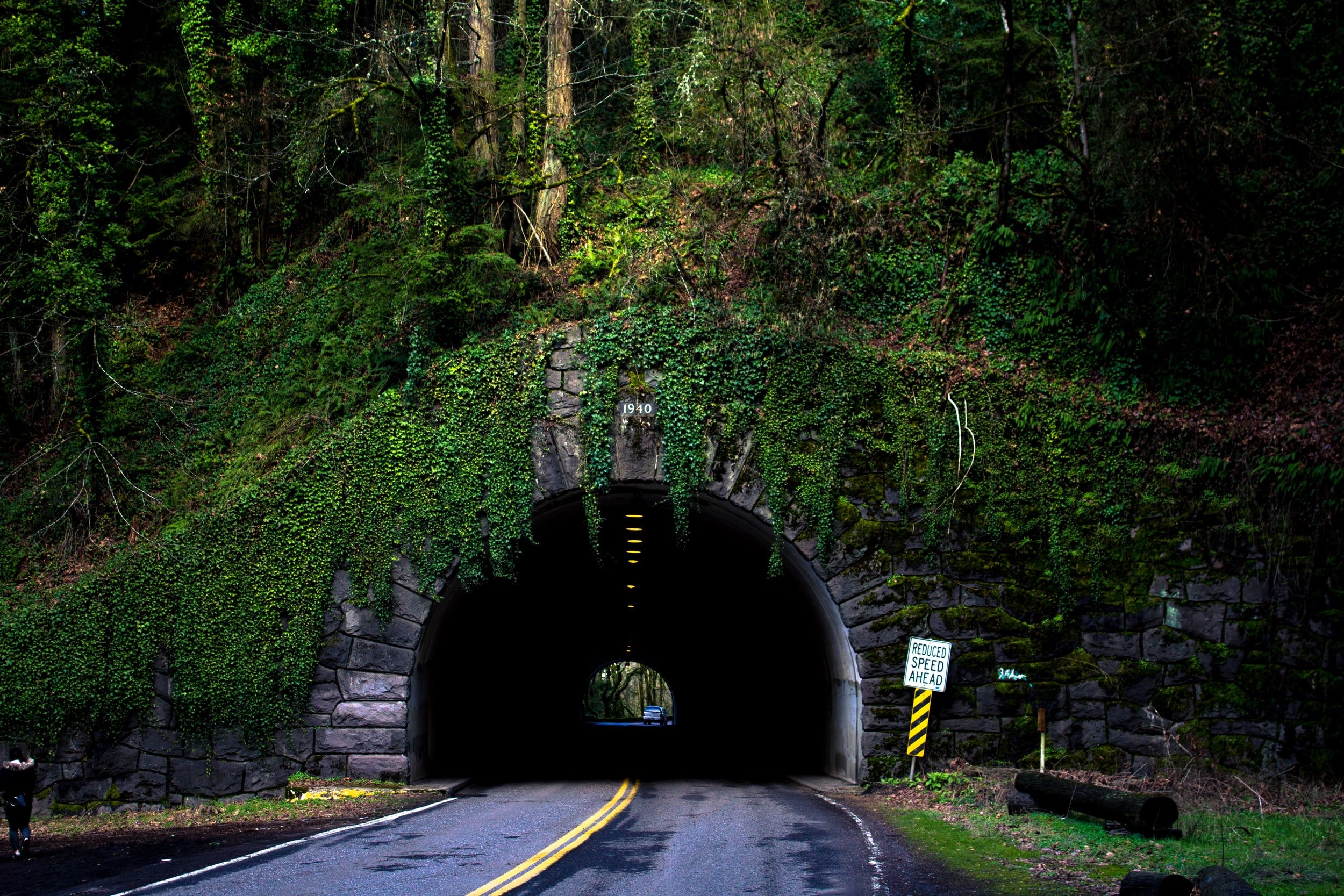
About the Plan
Why Oregon needs to reduce greenhouse gas emissions from transportation
Greenhouse gas emissions are a key contributor to human-influenced climate change. In Oregon, greenhouse gas emissions from transportation are about 35% of total emissions and represent the largest sector of emissions.
In response, the Oregon Departments of Transportation, Energy, Environmental Quality, and Land Conservation and Development are working together to reduce emissions from transportation to 80% below 1990 levels by 2050.



ODOT created this website, and will regularly update it to report on Oregon’s progress to reduce transportation emissions.
Oregon’s emission reduction strategy
The Statewide Transportation Strategy: A 2050 Vision for Greenhouse Gas Emissions Reduction is Oregon’s roadmap to substantial emission reductions. The strategy contains key actions that agencies, private industry, and Oregonians can take to reduce greenhouse gas emissions from transportation. The majority of specific actions in each of the six transportation categories come from the Statewide Transportation Strategy.
Oregon state agencies have built on the Statewide Transportation Strategy for the last decade, and are working within their authority under various programs and policies to reduce emissions from transportation. They’re also operating under new laws passed by the Oregon Legislature.
Using the new policies, programs and laws, state government’s current analysis show Oregon reducing emissions nearly 60% below 1990 levels by 2050. It’s short of the 80% goal, but still a dramatic improvement from 2018 projections. (See the Progress page for how Oregon can reach an 80% reduction.)
Each agency is working toward the common 80% reduction goal. That goal created two objectives, and those two objectives are driven by actions in six transportation categories.
One Goal
Reduce emissions from transportation to 80% below 1990 levels by 2050.
Two objectives
Reduce growth in vehicle miles traveled
Every vehicle trip by Oregonians produces greenhouse gas emissions. Oregon state agencies use land use laws, incentives and policies to support reductions in the number of driving trips people take, and how far they drive each trip.
Categories that drive this objective are Land Use; Transportation Options; System Operations; and Pricing, Funding and Markets.
Clean up each vehicle mile
“Clean” vehicle miles produce low or no greenhouse gas emissions. Success in this objective relies on new technology to reduce emissions via the kinds of vehicles people drive, such as electric, and the kinds of fuels used to power those vehicles.
Categories that drive this objective are Vehicle Technology, Fuel Technology, and System Operations.
The role of government, private industry, and the public
Reaching Oregon’s 2050 emissions goal will take a collaborative effort between local, state and federal government, Oregon’s business community, and average people in Oregon.
State, local and federal governments can strive to provide transportation choices that are low or no emission. Active modes of transportation, like walking or biking, should be equally attractive, convenient, and accessible as driving in many areas across the state. Governments can also pass climate-focused legislation, offer incentives for consumers, and enforce regulations to curb emissions.
Oregon’s private industry works within state and federal laws and regulations to advance cleaner vehicle and fuel technology, develop affordable low-emission transportation options, and more.
Oregonians can do their part by making climate-friendly choices. For some people, that may mean buying an electric car as their next vehicle. For others, it may be choosing to walk to work. Even taking the time to comment at a government public meeting, and supporting the actions on this website, can have a positive effect.
How reducing emissions will make Oregon better
Household savings
Enabling opportunities to walk, bike, or roll, and take transit will lead to fewer personal vehicle trips and thus less money spent on vehicle maintenance, gas, tolls, and other costs. Many non-driving options also encourage a healthy lifestyle, and fewer cars on the roads will keep Oregon’s air cleaner. Healthier people means lower health care costs, too.
Safe and reliable roads
Building roads with non-driving modes in mind, like walking/rolling or biking, means more safety for those users and drivers. More safety means fewer crashes, too, which creates a more reliable trip for all road users.
Stronger economy
Investing in infrastructure and incentives that spur a transition from fossil fuel options like gasoline and diesel to low emission fuels can help insulate Oregon’s economy from instability in the global energy market. It will also create new jobs for Oregonians in sustainable fields.
The state’s economy will also benefit from the forward-thinking land use policies. As Oregon’s population and economy grows, state and local policies will ensure people, goods and services can move efficiency through Oregon’s communities.
Cleaner environment and healthier communities
Advancing the shift to vehicles and fuels that release less greenhouse gas emissions results in cleaner air, better quality of life and healthier communities. Plus, with Oregon less reliant on fossil fuels, that means negative environmental impacts of resource extraction — like drilling accidents or spills during transport — are less likely.
History of Oregon’s emissions reduction work
Oregon state and local governments have been working to reduce greenhouse gas emissions for over a decade.
2013: the Statewide Transportation Strategy
The Oregon Department of Transportation worked with other state agencies and partners to develop the Statewide Transportation Strategy: A 2050 Vision for Greenhouse Gas Emissions Reduction. The strategy identifies key actions that agencies, private industry, and Oregonians could take to reduce greenhouse gas emissions from transportation through the year 2050. It follows goals set by the state legislature, and was grounded in peer-reviewed science. The strategy called for a 75% reduction in emissions. The resulting analysis of the strategy found that 60% reduction for all vehicles was feasible, and 80% reduction from just passenger vehicles.
2013 - 2018: following the strategy and checking progress
The state, led by the Oregon Department of Transportation, starts to implement the actions in the Statewide Transportation Strategy. Several agencies enact new policies, and the state legislature passes several new laws that will reduce emissions from transportation.
Oregon and neighbor states collaborate to build on the West Coast Electric Highway and form an eight-state electric vehicle action plan.
ODOT conducts early research that leads to the OReGO road user charge program.
Portland, Eugene-Springfield and Rogue Valley metropolitan areas complete scenario planning for emission reduction efforts.
ODOT uses new traffic flow technology to tackle bottlenecks on Portland area interstates and highways.
ODOT establishes a statewide Transportation Options program and updates the Bike and Pedestrian Plan to support emission reduction strategies.
ODOT and others review the work they had done to see if their current path could achieve the emission reduction goals set in the Statewide Transportation Strategy.
Unfortunately, the analysis reveals the state has to do more. If the path laid out in 2018 continues into the future, Oregon would miss its 2050 climate goal.
2018 - 2022: getting back on track
In 2020, Governor Kate Brown issues Executive Order 20-04 which revises the original transportation emission reduction goal set by the state legislature to 80% below 1990 levels by 2050.
The order also directs state agencies to work within their authority to expand past the goals stated in the Statewide Transportation Strategy. Actions include more funding to climate-friendly programs, further revising policies, and adopting aggressive new regulations on vehicles and fuels. ODOT and other state agencies form Every Mile Counts in 2020. The multi-agency collaboration aims to get Oregon back on track with the Statewide Transportation Strategy goals.
In 2022, state agencies check their progress after making adjustments over the last four years. The news is good: analysis indicates that if 2022 trends continued into the future, Oregon would reach nearly 60% below 1990 emission levels by 2050, a dramatic improvement from 2018’s outlook. (See graph above.)

“We need to think about every dimension of a trip and what can make it greener. Can we use design to reduce the necessity of some of the trips that people take? When people do take a trip can we create alternatives to take those trips in different modes? If the mode is going to be a vehicle trip, privately owned vehicles, how do we ensure that vehicle is as green as possible?”











